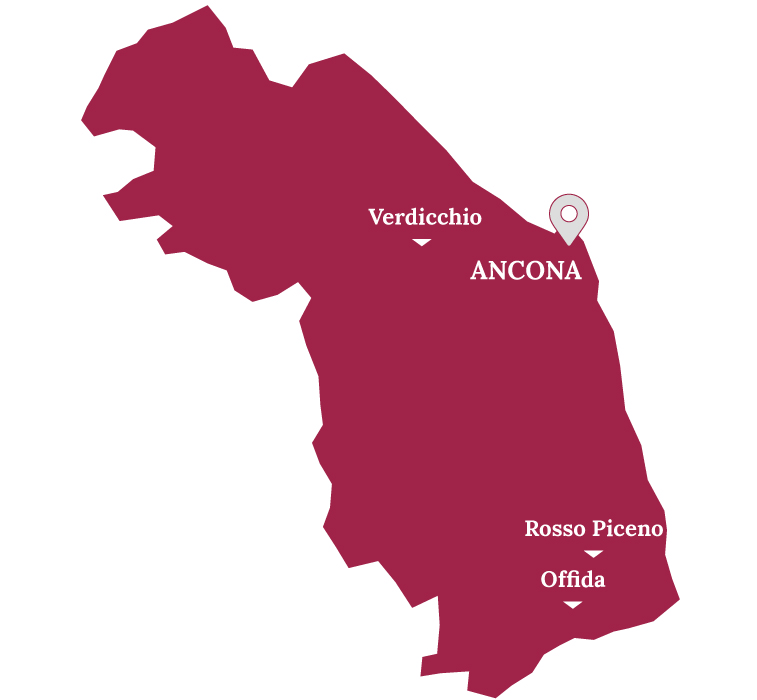Italy’s winemaking quality revolution of the 1960s coincided with a golden era for the historic native, Verdicchio. The name comes from verde, meaning “green,” because even when perfectly ripe, the grapes maintain their characteristic greenish hues. Ampelographers believe the variety may be related to Trebbiano di Soave and/or Trebbiano di Lugana. The grape originated in the hills crossed by the Esino river, where Marche’s winemaking history began. Aesis, a Roman colony – later Jesi – was located in this area, with its castles (hence Castelli di Jesi) and nearby temple of Cupra (ancient Roman goddess of fertility), where the locals would hold ritualistic ceremonies that featured the probable ancestor of Verdicchio, drunk in the goddess’ honor. Legend has it that in the last years of the Roman Empire, when Visigoth King Alaric I moved through the Marche to attack Rome in 410 AD, he loaded forty mules with barrels of Verdicchio, believing that nothing like this beautiful white could keep his soldiers healthy and fit. Unfortunately for Rome, the Verdicchio worked. Today, the core zone of historic Verdicchio dei Castelli di Jesi bears the Classico label, and Verdicchio is considered one of Italy’s noblest native whites, so much so that the Riserva version (aged 2 years) was awarded DOCG status in 2009. There is no single style of Verdicchio, for it can range from verdant and fresh to golden and richly textured. The Verdicchio of the Castelli di Jesi has a history dating back centuries. Its precise structure maintained equal over time has helped it become one of the most renowned whites in the world. A cultivator once said: De solar claritade et virtù eccellentissime, meaning “of singular clarity and excellent virtues.” A very interesting peculiarity about Verdicchio is that it can only be made in the Castelli di Jesi area. The particular soil of this area, its favorable climactic conditions, and most importantly, its constant ventilation, which prevents humidity from reaching its vines, make Verdicchio as exceptional as it is. It is often straw yellow, sometimes with subtle green highlights, which turn golden over time. Its scent is delicate and fresh, with a persistently fruity nose and a hint of bitter almonds. Its impeccable palate is dry, fine and harmonious, slightly bitter on the finish.Italy’s winemaking quality revolution of the 1960s coincided with a golden era for the historic native, Verdicchio. The name comes from verde, meaning “green,” because even when perfectly ripe, the grapes maintain their characteristic greenish hues. Ampelographers believe the variety may be related to Trebbiano di Soave and/or Trebbiano di Lugana. The grape originated in the hills crossed by the Esino river, where Marche’s winemaking history began. Aesis, a Roman colony – later Jesi – was located in this area, with its castles (hence Castelli di Jesi) and nearby temple of Cupra (ancient Roman goddess of fertility), where the locals would hold ritualistic ceremonies that featured the probable ancestor of Verdicchio, drunk in the goddess’ honor. Legend has it that in the last years of the Roman Empire, when Visigoth King Alaric I moved through the Marche to attack Rome in 410 AD, he loaded forty mules with barrels of Verdicchio, believing that nothing like this beautiful white could keep his soldiers healthy and fit. Unfortunately for Rome, the Verdicchio worked. Today, the core zone of historic Verdicchio dei Castelli di Jesi bears the Classico label, and Verdicchio is considered one of Italy’s noblest native whites, so much so that the Riserva version (aged 2 years) was awarded DOCG status in 2009. There is no single style of Verdicchio, for it can range from verdant and fresh to golden and richly textured. The Verdicchio of the Castelli di Jesi has a history dating back centuries. Its precise structure maintained equal over time has helped it become one of the most renowned whites in the world. A cultivator once said: De solar claritade et virtù eccellentissime, meaning “of singular clarity and excellent virtues.” A very interesting peculiarity about Verdicchio is that it can only be made in the Castelli di Jesi area. The particular soil of this area, its favorable climactic conditions, and most importantly, its constant ventilation, which prevents humidity from reaching its vines, make Verdicchio as exceptional as it is. It is often straw yellow, sometimes with subtle green highlights, which turn golden over time. Its scent is delicate and fresh, with a persistently fruity nose and a hint of bitter almonds. Its impeccable palate is dry, fine and harmonious, slightly bitter on the finish.
Map of the region

